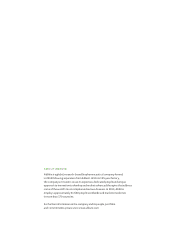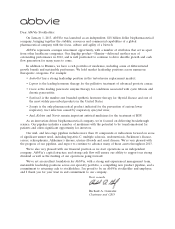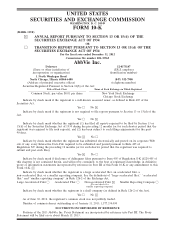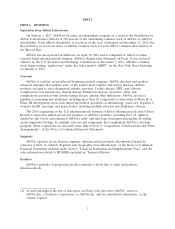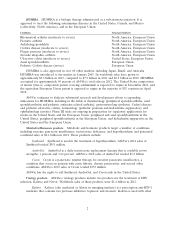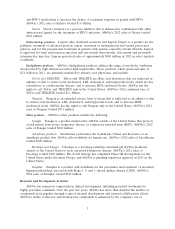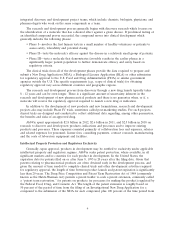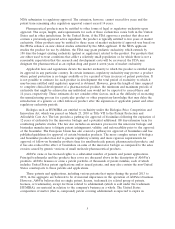AbbVie 2012 Annual Report Download - page 12
Download and view the complete annual report
Please find page 12 of the 2012 AbbVie annual report below. You can navigate through the pages in the report by either clicking on the pages listed below, or by using the keyword search tool below to find specific information within the annual report.December 2016, and the equivalent European Union patent is expected to expire in the majority of
EU countries in April 2018.
In addition, the following patents, licenses, and trademarks are significant: those related to
lopinavir/ritonavir (which is sold under the trademarks Kaletra and Aluvia), those related to fibric acid
derivatives (which are sold under the trademarks TriCor and TRILIPIX), those related to niacin (which
is sold under the trademarks Niaspan and Simcor), and those related to testosterone (which is sold
under the trademark AndroGel). The United States composition of matter patent covering lopinavir is
expected to expire in 2016. The principal United States non-composition of matter patent covering
lopinavir/ritonavir is expected to expire in 2016. The principal United States non-composition of matter
patents covering the fibric acid derivative products are expected to expire in 2018, 2020, 2023, and
2025. The principal United States non-composition of matter patents covering the niacin products are
expected to expire in 2013, 2017, and 2018. The principal non-composition of matter patent covering
AndroGel is expected to expire in 2020 for the 1.62 percent formulation and, due to pediatric
exclusivity, in 2021 for the 1 percent formulation. Agreements that may affect exclusivity are discussed
in Item 7, ‘‘Management’s Discussion and Analysis of Financial Condition and Results of Operations—
Results of Operations.’’
AbbVie may rely, in some circumstances, on trade secrets to protect its technology. However, trade
secrets are difficult to protect. AbbVie seeks to protect its technology and product candidates, in part,
by confidentiality agreements with its employees, consultants, advisors, contractors, and collaborators.
These agreements may be breached and AbbVie may not have adequate remedies for any breach. In
addition, AbbVie’s trade secrets may otherwise become known or be independently discovered by
competitors. To the extent that AbbVie’s employees, consultants, advisors, contractors, and
collaborators use intellectual property owned by others in their work for the company, disputes may
arise as to the rights in related or resulting know-how and inventions.
Sales, Marketing, and Distribution Capabilities
In 2012, AbbVie’s products were sold in over 170 countries. AbbVie utilizes a combination of
dedicated commercial resources, regional commercial resources and distributorships to market, sell, and
distribute its products worldwide.
In the United States, AbbVie distributes pharmaceutical products principally through independent
wholesale distributors, with some sales directly to pharmacies. In 2012, three wholesale distributors
accounted for substantially all of AbbVie’s sales in the United States. Sales to McKesson Corporation,
Cardinal Health, Inc., and AmerisourceBergen Corporation accounted for 38 percent, 27 percent, and
26 percent, respectively, of AbbVie’s 2012 gross sales in the United States. These wholesalers purchase
product from AbbVie under standard terms and conditions of sale.
AbbVie directs its primary marketing efforts toward securing the prescription, or recommendation,
of its brand of products by physicians, key opinion leaders, and other health care providers. Managed
care providers (for example, health maintenance organizations and pharmacy benefit managers),
hospitals, and state and federal government agencies (for example, the United States Department of
Veterans Affairs and the United States Department of Defense) are also important customers. AbbVie
also markets directly to consumers themselves, although all of the company’s products must be sold
pursuant to a prescription in the United States. Outside of the United States, AbbVie focuses its
marketing efforts on key opinion leaders, payors, physicians, and country regulatory bodies. AbbVie
also provides patient support programs closely related to its products.
AbbVie’s products are generally sold worldwide directly to wholesalers, distributors, government
agencies, health care facilities, specialty pharmacies, and independent retailers from AbbVie-owned
distribution centers and public warehouses. Outside the United States, sales are made either directly to
customers or through distributors, depending on the market served. Approximately 55-60 percent of
6


